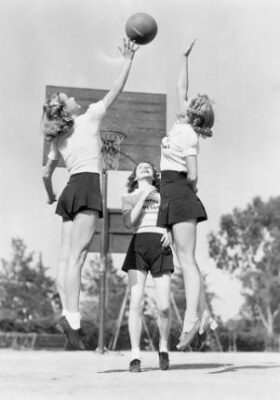Since the game was established in 1892 by James Naismith at Springfield College in Springfield, Massachusetts, ball garbs have changed more than some other game ever. Truth be told, an audit of the historical backdrop of ball regalia shows that players have worn everything from pants to turtlenecks to the silk shorts that are recognizable today.

Ev006111beginning of the Sport: 1892-1920
In spite of the fact that players started handling a ball in a topsy turvy peach bushel in 1891, official standards for the game were not formulated until 1892. For the initial eight years, the game was played, loose pants and fleece undershirts were what the players generally wore, for the most part since that was their clothing every day. In the mid-1920s, as the game developed more famous on school grounds, association authorities chose to organize what players wore to stay away from the ball is passed to a player of the rival group.
Check this: Basketball Jersey Maker
Composed Uniforms: 1920-1940
The historical backdrop of ball garbs shows more coordination among players somewhere in the range of 1920 and 1940 as they started wearing mid-length shorts and shirts made of fleece. The shirts were secured like a current-day bodysuit to hold them back from becoming untucked. Spalding made a portion of the primary cushioned shorts worn by ballplayers during this time. Ladies and youngsters were needed to wear kneepads during ball games.
Engineered Fabrics: 1940-1960
With the approach of engineered materials, the historical backdrop of b-ball regalia accepted one more turn as the hot, hard-to-wash fleece garbs were supplanted by more slender polyester and nylon variants. The jeans developed more limited, becoming brief-style by the mid-1960s, while the shirts became track-style pullovers. During the 1950s, players wore belts with their glossy silk shorts. The belts were dispensed with during the 1960s, and flexible belts were added.
Perfectly sized: 1960-1988
As the free-form period of the 1960s started, b-ball outfits took on another look, becoming tighter and more perfectly sized. Players wore longer, striped cylinder socks during games, and headbands became normal to keep longer haircuts out of the eyes of players. MacGregor Sand-Knit turned into the authority NBA supplier in 1982, giving a cotton/polyester mix uniform that was more agreeable. It was during this time that shirts developed more vivid also. By the mid-1970s, glossy silk shorts were supplanted by pinhole network material and shirts became looser to consider better player development.
Check this: Custom Basketball Jerseys
Michael Jordan request: 1988-2000
In 1987, Michael Jordan mentioned that the games producer Champion, who made all NBA outfits at that point, make his shorts in a more extended rendition. He needed something to clutch when he twisted around on the court, exhausted from playing. The next year, Champion made the uniform form that is utilized today. Adidas turned into the authority NBA uniform supplier during the 2000s, and in 2013, the Warriors turned into the principal NBA group to wear shirts with sleeves.
The Popularity of Sublimated Uniforms: 2000-Present
A little previously or later in the 2000s, the advancement of ball outfits changed to customization strategies. Screen printing turned into a less famous decision because of the ubiquity of sublimated ball regalia the cycle by which ink is straightforwardly moved in the texture rather than over it. It is difficult to pinpoint precisely when sublimated b-ball outfits began entering AAU courts all around the US. While sublimation innovation began way, harking back to the 20s for business printing of plastics and acrylics, it was not until the ’50s that was utilized for polyester textures. By the mid-70s, NASA fostered the main PC-based sublimation framework and around the year 2000, it began infiltrating the activewear business. At first more costly to create than customary tackle twill outfits progresses in innovation and large-scale manufacturing have now permitted it to be the result of decision for a regular AAU or youth ball group hoping to tweak their own look without burning through every last dollar. Sublimation permitted a group to utilize colors not accessible in standard texture color parcels, for example, cardinal red, vegas gold, Texas orange, neon pink, and every one of the shades in the middle.
What Does 2020 Have in Store for Basketball Uniforms?
With the beginning of programming and assembling innovation, cutthroat organizations like Allen Sportswear have enabled mentors and players to think of their remarkable search for their b-ball garbs by picking the latest things or legacy choices like thin fit b-ball pullovers and adaptable b-ball shorts inseams. Its wide choice of b-ball uniform plans incorporates slipover or self-material cut, conventional sleeveless b-ball shirts or old-school short-sleeved b-ball pullovers, racerback, or ladies’ cut for young ladies b-ball outfits, and lightweight reversible b-ball regalia. Its ongoing web-based manufacturer permits the b-ball mentor or player to browse standard and custom tones, pick any lettering or numbering textual style, look over stock mascots or transfer their own group logos, add sublimated examples, change murkiness and slope and move up to a neck score with initials. The force of personalization has detonated the development of the customer business from vehicles to key chains, and b-ball garbs are not absolved.
The “free” b-ball shirts and longer b-ball shorts pattern pretty filth stuck on and off the court with current b-ball uniform plans showing the NBA, universities, and secondary schools actually favoring the customary tackle twill garbs and the cut and sew designs versus the more savvy sublimated b-ball outfits, yet with completely custom producers, for example, Allen Sportswear, clients presently can pick from both application techniques or join them to concoct the smartest possible solution for their groups.

